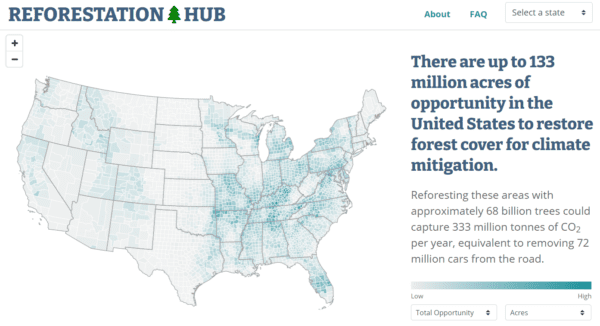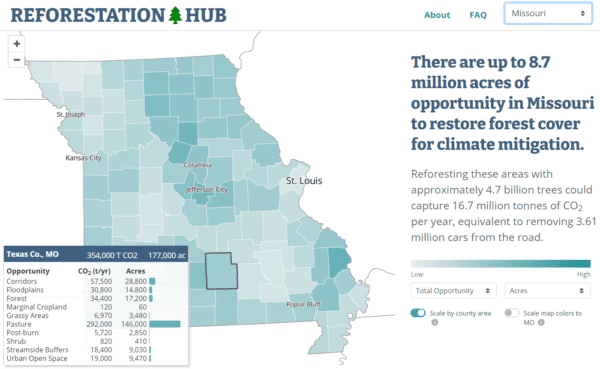By Eric Sprague, American Forests’ Vice President of Forest Restoration
White oaks are known as the “kings” of eastern forests for their huge stature, abundance, and provision of natural benefits like wildlife habitat. But the future of this important species is at risk. There is an almost complete absence of young white oaks in woodlands along the East Coast. Recent analysis by the White Oak Initiative shows that almost 90% of mature white oak acres in the east have no oak saplings present.
Young white oaks are rapidly declining for a variety of reasons, including the suppression of natural, low-intensity fires that open clearings where young oaks can thrive. The best way to ensure white oaks remain in future forests is through management actions like reforestation — which includes planting more oaks and creating openings to encourage natural oak regrowth. A new tool, the Reforestation Hub, can help land managers identify the best places to restore oaks and other types of trees.

American Forests is excited to partner with The Nature Conservancy on this online mapping tool, which uses data from a recent Nature Conservancy paper published in One Earth. The Reforestation Hub allows users to identify reforestation opportunities across the landscape and inform strategies for ramping up forest restoration in their region. It breaks out the data across private and public ownerships, states and counties, and important land features like floodplains and habitat corridors. It offers the most detailed, comprehensive reforestation data available for the contiguous United States.
This tool makes reforestation project planning more effective and efficient, and will help make the case for investment in these projects. This tool is accessible for a wide audience, including foresters, conservation organizations, legislators, natural resource agency staff and anyone else who is interested in using trees to fight climate change and improve quality of life.
The Reforestation Hub also lets users determine how much carbon a given area can store if fully reforested. Overall, according to the analysis in One Earth, reforesting ecologically appropriate areas in the Lower 48 would require roughly 68 billion trees, and would absorb 333 million metric tons of carbon dioxide per year. This is the equivalent of removing 5% of annual U.S. greenhouse gas emissions, equal to the yearly emissions of 72 million cars. This underscores the fact that reforestation is one of our best natural climate solutions.
Growing and planting this many trees will require a large amount of investment and labor. One promising way to accomplish this is via the soon-to-be-introduced REPLANT Act. The REPLANT Act would remove the artificial $30 million cap on the Reforestation Trust Fund, freeing up additional funding to reforest and restore national forests.
The five states with the most reforestation opportunity — Missouri, Kentucky, Tennessee, Arkansas and Ohio — have one thing in common: They are the heart of Oak Country. The climate and soils of these states are particularly conducive to growing big oaks. A large-scale management and reforestation initiative will be critical to sustaining white oaks in this region.

The Reforestation Hub can help agencies, conservation groups and private citizens identify where in their regions reforestation potential exists. Texas County, located in the Ozarks of Southern Missouri and adjacent to the Mark Twain National Forest, has 177,000 acres of reforestation potential. This region of Missouri grows some of the finest white oak in the country. This is particularly true for the type of tight-grained wood that is so valuable for making whiskey and wine barrels.
Within Texas County, the majority of reforestation opportunity occurs on privately owned pastureland. Additionally, reforestation projects can be designed to meet other goals like improving water quality, flood control and wildlife habitat. In Texas County, there are 15,000 acres of reforestation opportunity in floodplains, 17,000 acres within existing forestlands and nearly 30,000 acres in “biological corridors” that would help connect wildlife pathways.
Newly reforested white oaks in Texas County and other areas won’t only be good for barrel making. They will also offer critical food and shelter for wildlife. Across the Mid-Atlantic, white oaks provide habitat for more than 500 species of moths and butterflies — more than any other woody plant in the region. With the right forest management, and the use of tools such as the Reforestation Hub, we can ensure that white oaks will continue their reign for generations to come.